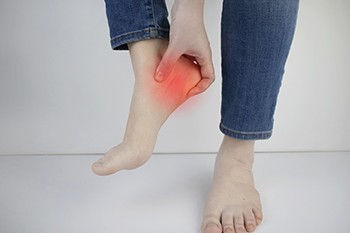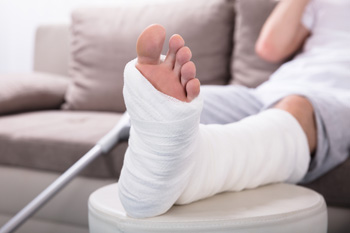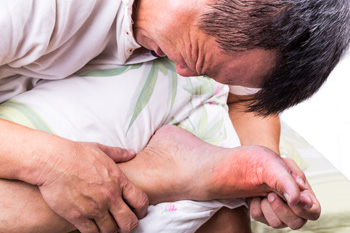Items filtered by date: August 2021
Risk Factors and Treatments for Plantar Fasciitis
 Plantar fasciitis, which is one of the most common causes of heel pain, occurs when there is inflammation or degeneration of the plantar fascia, the band of tissue that runs along the bottom of the foot from the heel to the toes. While plantar fasciitis is an overuse injury, there are a variety of other factors that contribute to it, including wearing unsupportive footwear, being overweight, or having overpronated feet or tight calf muscles. Patients who are suffering from pain in the heel that develops over time, is worse in the morning, and causes tenderness in the arch of the foot, should consult with a podiatrist to confirm the source of the pain. If the heel pain is a result of plantar fasciitis, your podiatrist will have a variety of treatment methods to help you that may include cold therapy, taping the arch of the foot, orthotics, splints or medications.
Plantar fasciitis, which is one of the most common causes of heel pain, occurs when there is inflammation or degeneration of the plantar fascia, the band of tissue that runs along the bottom of the foot from the heel to the toes. While plantar fasciitis is an overuse injury, there are a variety of other factors that contribute to it, including wearing unsupportive footwear, being overweight, or having overpronated feet or tight calf muscles. Patients who are suffering from pain in the heel that develops over time, is worse in the morning, and causes tenderness in the arch of the foot, should consult with a podiatrist to confirm the source of the pain. If the heel pain is a result of plantar fasciitis, your podiatrist will have a variety of treatment methods to help you that may include cold therapy, taping the arch of the foot, orthotics, splints or medications.
Plantar fasciitis is a common foot condition that is often caused by a strain injury. If you are experiencing heel pain or symptoms of plantar fasciitis, contact one of our podiatrists from Bruening Foot & Ankle. Our doctors can provide the care you need to keep you pain-free and on your feet.
What Is Plantar Fasciitis?
Plantar fasciitis is one of the most common causes of heel pain. The plantar fascia is a ligament that connects your heel to the front of your foot. When this ligament becomes inflamed, plantar fasciitis is the result. If you have plantar fasciitis you will have a stabbing pain that usually occurs with your first steps in the morning. As the day progresses and you walk around more, this pain will start to disappear, but it will return after long periods of standing or sitting.
What Causes Plantar Fasciitis?
- Excessive running
- Having high arches in your feet
- Other foot issues such as flat feet
- Pregnancy (due to the sudden weight gain)
- Being on your feet very often
There are some risk factors that may make you more likely to develop plantar fasciitis compared to others. The condition most commonly affects adults between the ages of 40 and 60. It also tends to affect people who are obese because the extra pounds result in extra stress being placed on the plantar fascia.
Prevention
- Take good care of your feet – Wear shoes that have good arch support and heel cushioning.
- Maintain a healthy weight
- If you are a runner, alternate running with other sports that won’t cause heel pain
There are a variety of treatment options available for plantar fasciitis along with the pain that accompanies it. Additionally, physical therapy is a very important component in the treatment process. It is important that you meet with your podiatrist to determine which treatment option is best for you.
If you have any questions, please feel free to contact our offices located in Covina and Alta Loma, CA . We offer the newest diagnostic and treatment technologies for all your foot care needs.
Different Stages of Gout
Gout is a type of arthritis caused by excess uric acid in the bloodstream. This acid can crystallize in the joints and cause symptoms like inflammation, swelling, stiffness, and pain. Gout can affect any joint, but frequently affects the joints of the big toe. Gout can progress into several stages. The first stage is asymptomatic hyperuricemia in which uric acid levels in the blood are elevated but do not cause any noticeable symptoms, although they may cause silent tissue damage. In the acute stage, sudden, painful gout flare ups that last between three days and two weeks can arise. The period between gout attacks is called the interval or intercritical period. If you suffer from gout it is suggested that you seek the care of a podiatrist.
Gout is a painful condition that can be treated. If you are seeking treatment, contact one of our podiatrists from Bruening Foot & Ankle. Our doctors will treat your foot and ankle needs.
What Is Gout?
Gout is a form of arthritis that is characterized by sudden, severe attacks of pain, redness, and tenderness in the joints. The condition usually affects the joint at the base of the big toe. A gout attack can occur at any random time, such as the middle of the night while you are asleep.
Symptoms
- Intense Joint Pain - Usually around the large joint of your big toe, and it most severe within the first four to twelve hours
- Lingering Discomfort - Joint discomfort may last from a few days to a few weeks
- Inflammation and Redness -Affected joints may become swollen, tender, warm and red
- Limited Range of Motion - May experience a decrease in joint mobility
Risk Factors
- Genetics - If family members have gout, you’re more likely to have it
- Medications - Diuretic medications can raise uric acid levels
- Gender/Age - Gout is more common in men until the age of 60. It is believed that estrogen protects women until that point
- Diet - Eating red meat and shellfish increases your risk
- Alcohol - Having more than two alcoholic drinks per day increases your risk
- Obesity - Obese people are at a higher risk for gout
Prior to visiting your podiatrist to receive treatment for gout, there are a few things you should do beforehand. If you have gout you should write down your symptoms--including when they started and how often you experience them, important medical information you may have, and any questions you may have. Writing down these three things will help your podiatrist in assessing your specific situation so that he or she may provide the best route of treatment for you.
If you have any questions, please feel free to contact our offices located in Covina and Alta Loma, CA . We offer the newest diagnostic and treatment technologies for all your foot care needs.
Why Live with Pain and Numbness in Your Feet?
The Duties of a Podiatrist
 A podiatrist is a medical professional that specializes in the care of the feet and ankles. A podiatrist’s duties typically include examining patients, diagnosing various foot and ankle conditions, and providing the appropriate treatments for a variety of foot and ankle needs. Some podiatrists specialize in podiatric surgery and perform operations such as joint replacement surgeries and bunionectomies. Podiatrists are also often the first to notice signs of diabetes, neuropathy, peripheral artery disease, rheumatoid arthritis, and other systemic conditions that can affect the feet. In those cases, a podiatrist may not only treat your disease-related foot and ankle problems, but also refer you to a specialist for the suspected systemic disease. If you are experiencing any foot or ankle pain, don’t hesitate to schedule an appointment with a podiatrist near you.
A podiatrist is a medical professional that specializes in the care of the feet and ankles. A podiatrist’s duties typically include examining patients, diagnosing various foot and ankle conditions, and providing the appropriate treatments for a variety of foot and ankle needs. Some podiatrists specialize in podiatric surgery and perform operations such as joint replacement surgeries and bunionectomies. Podiatrists are also often the first to notice signs of diabetes, neuropathy, peripheral artery disease, rheumatoid arthritis, and other systemic conditions that can affect the feet. In those cases, a podiatrist may not only treat your disease-related foot and ankle problems, but also refer you to a specialist for the suspected systemic disease. If you are experiencing any foot or ankle pain, don’t hesitate to schedule an appointment with a podiatrist near you.
If you are experiencing pain in the feet or ankles, don’t join the stubborn majority refusing treatment. Feel free to contact one of our podiatrists from Bruening Foot & Ankle. Our doctors can provide the care you need to keep you pain-free and on your feet.
What Is a Podiatrist?
Someone would seek the care of a podiatrist if they have suffered a foot injury or have common foot ailments such as heal spurs, bunions, arch problems, deformities, ingrown toenails, corns, foot and ankle problems, etc.
Podiatric Treatment
A podiatrist will treat the problematic areas of the feet, ankle or lower leg by prescribing the following:
- Physical therapy
- Drugs
- Orthotic inserts or soles
- Surgery on lower extremity fractures
A common podiatric procedure a podiatrist will use is a scanner or force plate which will allow the podiatrist to know the designs of orthotics. Patients are then told to follow a series of tasks to complete the treatment. The computer will scan the foot a see which areas show weight distribution and pressure points. The podiatrist will read the analysis and then determine which treatment plans are available.
If you have any questions please feel free to contact our offices located in Covina and Alta Loma, CA . We offer the newest diagnostic and treatment technologies for all your foot and ankle needs.
Who Can Rupture Their Achilles Tendon?
An Achilles tendon rupture occurs when the tendon, located at the back of the calves, tears completely due to physical activities. Anyone can rupture their Achilles tendon. Ruptures can occur suddenly and without warning, especially in people who participate in sports like basketball or tennis, which involve a lot of sprinting or pushing off. But even if you might not be able to predict an Achilles tendon rupture based on pain prior to the injury, there are certain people who are more at risk than others. People who are older, have poor flexibility, lead an inactive lifestyle, take steroid medications or certain antibiotics, and those who have diabetes, gout, rheumatoid arthritis, or kidney disease are most at risk. Another group that may have to deal with an Achilles tendon rupture are “weekend warriors.” These are people who participate in sports or other exercise only occasionally. Achilles tendon ruptures are characterized by the abrupt onset of pain akin to being kicked in the back of the leg, hearing or feeling a pop at the time of injury, and weakness, bruising, or swelling of the affected leg. If these symptoms sound familiar to you, please seek the care of a podiatrist.
Achilles tendon injuries need immediate attention to avoid future complications. If you have any concerns, contact one of our podiatrists of Bruening Foot & Ankle. Our doctors can provide the care you need to keep you pain-free and on your feet.
What Is the Achilles Tendon?
The Achilles tendon is a tendon that connects the lower leg muscles and calf to the heel of the foot. It is the strongest tendon in the human body and is essential for making movement possible. Because this tendon is such an integral part of the body, any injuries to it can create immense difficulties and should immediately be presented to a doctor.
What Are the Symptoms of an Achilles Tendon Injury?
There are various types of injuries that can affect the Achilles tendon. The two most common injuries are Achilles tendinitis and ruptures of the tendon.
Achilles Tendinitis Symptoms
- Inflammation
- Dull to severe pain
- Increased blood flow to the tendon
- Thickening of the tendon
Rupture Symptoms
- Extreme pain and swelling in the foot
- Total immobility
Treatment and Prevention
Achilles tendon injuries are diagnosed by a thorough physical evaluation, which can include an MRI. Treatment involves rest, physical therapy, and in some cases, surgery. However, various preventative measures can be taken to avoid these injuries, such as:
- Thorough stretching of the tendon before and after exercise
- Strengthening exercises like calf raises, squats, leg curls, leg extensions, leg raises, lunges, and leg presses
If you have any questions please feel free to contact our offices located in Covina and Alta Loma, CA . We offer the newest diagnostic tools and technology to treat your foot and ankle needs.
Is My Foot Broken, or Sprained?
 A fractured foot and a sprained foot can be difficult to tell apart as both conditions share several symptoms. A broken foot is typically more painful than a sprained foot, and the pain tends to last longer. Bruising, swelling, and tenderness are associated with both fractures and sprains, but are usually more severe in fractures. At the time of injury, you may hear a crack if there is a fracture, but a popping sound may occur if there is a sprain. Both fractures and sprains are likely to cause difficulty walking or bearing weight on the affected foot. If you have injured your foot, a podiatrist can use a combination of physical examination and imaging studies like X-rays, to determine the type of injury you have endured and which course of treatment is best for you.
A fractured foot and a sprained foot can be difficult to tell apart as both conditions share several symptoms. A broken foot is typically more painful than a sprained foot, and the pain tends to last longer. Bruising, swelling, and tenderness are associated with both fractures and sprains, but are usually more severe in fractures. At the time of injury, you may hear a crack if there is a fracture, but a popping sound may occur if there is a sprain. Both fractures and sprains are likely to cause difficulty walking or bearing weight on the affected foot. If you have injured your foot, a podiatrist can use a combination of physical examination and imaging studies like X-rays, to determine the type of injury you have endured and which course of treatment is best for you.
A broken foot requires immediate medical attention and treatment. If you need your feet checked, contact one of our podiatrists from Bruening Foot & Ankle. Our doctors can provide the care you need to keep you pain-free and on your feet.
Broken Foot Causes, Symptoms, and Treatment
A broken foot is caused by one of the bones in the foot typically breaking when bended, crushed, or stretched beyond its natural capabilities. Usually the location of the fracture indicates how the break occurred, whether it was through an object, fall, or any other type of injury.
Common Symptoms of Broken Feet:
- Bruising
- Pain
- Redness
- Swelling
- Blue in color
- Numbness
- Cold
- Misshapen
- Cuts
- Deformities
Those that suspect they have a broken foot shoot seek urgent medical attention where a medical professional could diagnose the severity.
Treatment for broken bones varies depending on the cause, severity and location. Some will require the use of splints, casts or crutches while others could even involve surgery to repair the broken bones. Personal care includes the use of ice and keeping the foot stabilized and elevated.
If you have any questions please feel free to contact our offices located in Covina and Alta Loma, CA . We offer the newest diagnostic and treatment technologies for all your foot and ankle needs.



